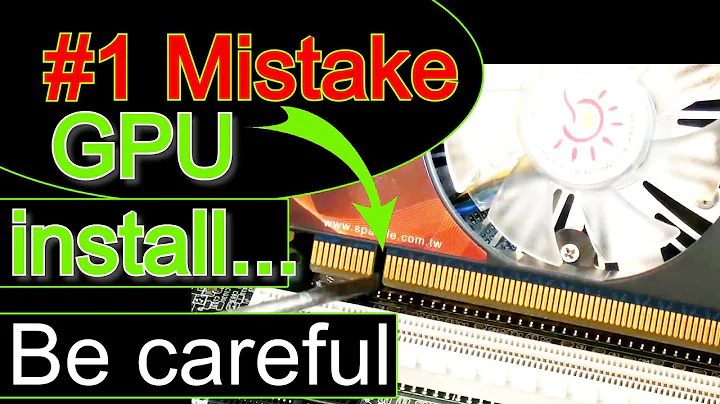GPU struggles only in the primary PCIe slot. Is this a motherboard issue?
Solution 1
If the GPU is using legacy interrupts for some reason, it may be suffering from high latency while the CPU is busy handling other interrupt handlers for that IRQ.
Your motherboard's user manual specifies that the PCIE x16_1 slot (the top one) shares IRQ assignments with the internal graphics, HD Audio, USB 2.0 (EHCI), and PCI 2 slot.
Modern motherboards with PCIe are supposed to be exposing interrupts over a newer system, so the existence of this chart in your user manual is unexpected.
The PCIE x16_2 has its own IRQ assignment, so it does not have to compete with any other components to raise an interrupt request. If the GPU performs better in that slot, this may be the explanation for better performance.
However, that slot is only PCIe 8x.
With PCIe 8x you might lose performance in some programs that are bandwidth heavy. That won't have a significant impact on FPS for most games though.
Solution 2
There should be no issues running your GPU in the second slot. That said, it's important to note that running any GPU in that means it only receives 8 PCIe lanes of bandwidth, instead of the full 16 it would get in the primary slot. However, since your GTX 960 is a relatively old and slow card, it's unlikely that having access to only half the lanes will bottleneck it in any way.
Should you be willing to invest the time and effort in actually tracking down and solving the issue so you can put the card back in the first slot (wouldn't blame you if you aren't!), be prepared to do some digging:
If your system has only recently started having problems, then assuming you haven't changed anything (i.e. updated BIOS or drivers), it is possible the motherboard is physically faulty. On the other hand, if you haven't updated the motherboard's BIOS or its drivers (especially for chipset and/or onboard sound), then now might be the time to do so.
It's also quite possible that a Windows update changed something thus causing this issue. If you can remember approximately when the issue started happening, it might be useful to review your machine's Windows Update history for updates around that time. As a last resort, if you have a spare SSD/HDD and some time, you can install a fresh copy of Windows on that drive then put the GPU back in the primary slot and see if it performs as it should. If so, you know something is broken in your current Windows install, and a reinstall will likely fix it.
Related videos on Youtube
Comments
-
 SuperHanz98 over 1 year
SuperHanz98 over 1 yearWhen my GPU is in the primary PCIe slot, I sometimes get loads of garbled sound when I run the audio through the HDMI. The GPU also performs far worse on benchmarks. In the primary slot I get 30 fps on Novabench, in the secondary slot I get 90 fps.
Is this a problem with the motherboard?
Specs:
-
Ramhound over 4 yearsHave you referred to the manual to verify your using a PCIex16 slot?
-
 SuperHanz98 over 4 yearsI know it's the right slot because it used to work perfectly well in that slot. It has only recently started having problems.
SuperHanz98 over 4 yearsI know it's the right slot because it used to work perfectly well in that slot. It has only recently started having problems. -
Natsu Kage over 4 yearsPrimary slot / secondary slot is pretty vague. Are you referring to the one closest to the CPU when you say Primary Slot? Have you checked the BIOS settings to be sure you're in x16 mode?
-
 SuperHanz98 over 4 yearsYeah the one closest to the CPU. It's definitely the slot that it SHOULD be in. But recently I've been having the problems described in the question with that slot, meaning I've had to move to one further away.
SuperHanz98 over 4 yearsYeah the one closest to the CPU. It's definitely the slot that it SHOULD be in. But recently I've been having the problems described in the question with that slot, meaning I've had to move to one further away. -
SpacePhoenix over 4 yearsJust googled for an image of that motherboard, have you tried using the on-board HDMI port?
-
alex.forencich over 4 yearsIf problems started recently, then I would suspect either hardware damage or software issues - perhaps a static discharge or similar damaged one or more PCIe lanes on either the GPU or the CPU, causing issues with the PCIe link; or maybe a bad driver version is causing trouble.
-
 SuperHanz98 over 4 years@alex.forencich. Thanks for this. I've got another GPU coming next week, it will be interesting to see if that fixes the problem. The fact that I also now seem to be getting much milder audio issues with the non-GPU audio output suggests that it might be the mobo.
SuperHanz98 over 4 years@alex.forencich. Thanks for this. I've got another GPU coming next week, it will be interesting to see if that fixes the problem. The fact that I also now seem to be getting much milder audio issues with the non-GPU audio output suggests that it might be the mobo. -
Romen over 4 years@Cutter, What CPU and version of Windows are you using? If you could tell us your BIOS version too that would be helpful. This info may clear up any confusion about whether those IRQ assignments have anything to do with this or not.
-
 SuperHanz98 over 4 yearsi5 4460, Windows 10, BIOS Version/Date - American Megatrends Inc. 0902, 08/05/2014. Also added to specs in question.
SuperHanz98 over 4 yearsi5 4460, Windows 10, BIOS Version/Date - American Megatrends Inc. 0902, 08/05/2014. Also added to specs in question.
-
-
 SuperHanz98 over 4 yearsThank you for this. I've been messing around with this problem for like a week now (bought another GPU and PSU that both need to be returned) I don't really have the time or the patience to do this any time soon. But when I do I will refer back to this post and let you know how it goes.
SuperHanz98 over 4 yearsThank you for this. I've been messing around with this problem for like a week now (bought another GPU and PSU that both need to be returned) I don't really have the time or the patience to do this any time soon. But when I do I will refer back to this post and let you know how it goes. -
 J... over 4 yearsAll three PCIe slots on that board are x16, at least as far as it seems to be documented in the manual. Why do you say only 8 lanes would be available?
J... over 4 yearsAll three PCIe slots on that board are x16, at least as far as it seems to be documented in the manual. Why do you say only 8 lanes would be available? -
 Ian Kemp over 4 years@J... Those slots are physically capable of accepting cards with up to an x16 connector, but the Z97 chipset and accompanying CPUs only provide a maximum of 16 PCIe lanes for graphics. These lanes are divided depending on which PCIe slots are populated: if slot 1 (topmost/primary) is populated it gets all 16, if slot 2 is populated slots 1 and 2 get 8 lanes each. This leaves no lanes for the bottommost PCIe slot, which is connected to the chipset (not CPU) by a mere 2 PCIe 2.0 lanes (slooow). Hence why motherboard manufacturers recommend installing the first GPU in the primary slot.
Ian Kemp over 4 years@J... Those slots are physically capable of accepting cards with up to an x16 connector, but the Z97 chipset and accompanying CPUs only provide a maximum of 16 PCIe lanes for graphics. These lanes are divided depending on which PCIe slots are populated: if slot 1 (topmost/primary) is populated it gets all 16, if slot 2 is populated slots 1 and 2 get 8 lanes each. This leaves no lanes for the bottommost PCIe slot, which is connected to the chipset (not CPU) by a mere 2 PCIe 2.0 lanes (slooow). Hence why motherboard manufacturers recommend installing the first GPU in the primary slot. -
 J... over 4 years@IanKemp I think, at least for OP's Z97-AR (see manual p.vi), if there's only one card in either PCIe x16_1 or PCIe x16_2 then either slot will operate with a full 16 lanes. I think they only get reduced to 8 lanes each if there's a card in both slots.
J... over 4 years@IanKemp I think, at least for OP's Z97-AR (see manual p.vi), if there's only one card in either PCIe x16_1 or PCIe x16_2 then either slot will operate with a full 16 lanes. I think they only get reduced to 8 lanes each if there's a card in both slots. -
alex.forencich over 4 yearsLooking at the motherboard pictures, only one slot is actually wired with all 16 lanes, the other two only have pins for 8 - it is not physically possible to get more than 8 lanes on any slot other than the first slot on that motherboard. So you must install the card in the first slot if you want it to use all 16 lanes. It's also probably that the second slot "steals" the top 8 lanes from the first slot - if you install a card in the 2nd slot, the first slot will then only run with 8 lanes.
-
alex.forencich over 4 yearsYep, looks like the second slot "steals" the top 8 lanes from the first slot. So you get 16 lanes only if you install the card in the first slot and leave the second slot empty. If you use the second slot, then the first two slots get 8 lanes each. And the third slot supports only two lanes of PCIe gen 2.
-
 DavidPostill over 4 yearsComments are not for extended discussion; this conversation has been moved to chat.
DavidPostill over 4 yearsComments are not for extended discussion; this conversation has been moved to chat.




